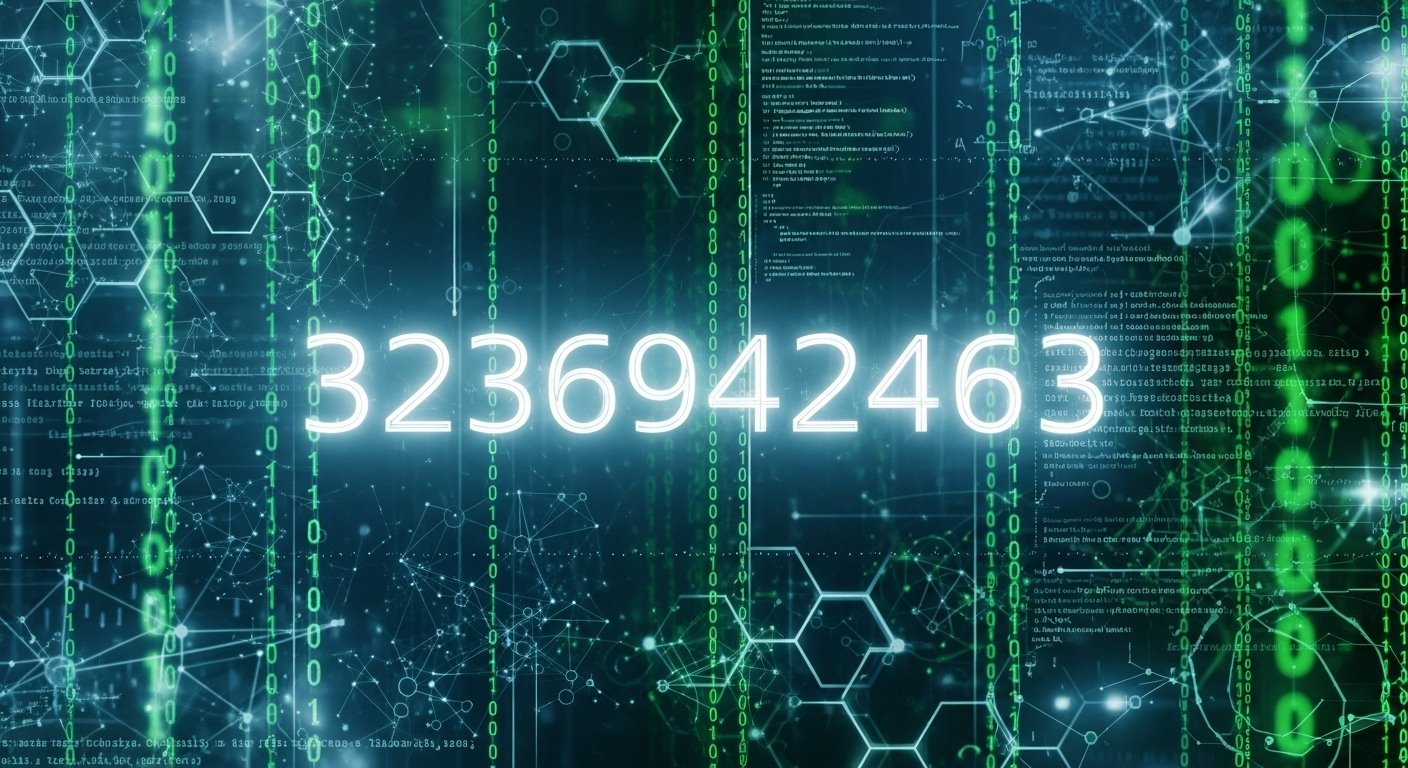In our digital world, strings of numbers often carry more meaning than meets the eye. Among them is 3236942463, a seemingly random sequence that shows up in various contexts—from computing to data identifiers. In this article, we’ll explore the significance of 3236942463, where it’s used, and how to interpret such numeric codes. Whether you stumbled across it in logs, programming, or as part of a dataset, this guide will help demystify its uses.
What Is 3236942463?
At its face, 3236942463 is a ten-digit number. But in many contexts, numbers aren’t just values—they are keys, IDs, checksums, or codes. To understand 3236942463, we must look into how numeric identifiers are used in technology, databases, networking, and more.
As an Identifier or Hash
Large unique numbers often serve as IDs in systems—such as user IDs, transaction IDs, or object identifiers. In some programming languages or systems, a 32-bit unsigned integer can go up to around 4,294,967,295. With a value of 3,236,942,463, 3236942463 fits well within that range. Thus, it’s plausible that this number is used as a unique identifier in a database or software module.
It may also be a part of a hash function result — e.g. a CRC, MD5 segment, or other numeric hash used to verify data integrity or as a key in a map.
Interpreting in Hexadecimal or Binary
When programmers see a long decimal, they often convert it to hexadecimal or binary to reveal patterns.
-
In hexadecimal, 3236942463 = 0xC0A8126F
-
In binary, that is 11000000101010000001001001101111
Sometimes that hex pattern is more recognizable: for example, C0A8 often relates to the IPv4 address block “192.168.x.x” (0xC0A8 = 192.168). This suggests that 3236942463 could be encoding an IP address or network-related data in a compact form.
Real-World Uses of 3236942463
Let’s examine scenarios where such a numeric code might appear.
1. IP Address Encoding
As mentioned, 0xC0A8126F can be broken down:
-
C0 A8 → 192.168 (common home network prefix)
-
12 6F → 18 and 111 → final octets
That suggests 3236942463 may represent the IPv4 address 192.168.18.111 when interpreted in big-endian form. Some software or logs store IP addresses as 32-bit unsigned integers rather than dotted decimals.
2. Database Keys / Primary IDs
In relational and NoSQL databases, primary keys are often large numbers. Suppose a system uses incremental 32-bit IDs—then 3236942463 might be simply the 3,236,942,463rd record or resource.
3. Software Internals, Session or Token IDs
Apps that generate session tokens, transaction numbers, or reference IDs frequently rely on randomly generated integers. When security or obscurity is needed, a number like 3236942463 may be issued to a user session, API call, or transaction.
4. Checksums, Hashes, or File Signatures
Though more commonly hashes are alphanumeric (hex or base64), systems may derive or reduce a hash into a large decimal for compact representation. 3236942463 could be part of a checksum used to detect data corruption or tampering.
How to Decode & Validate 3236942463
If you encounter 3236942463 in logs or code and want to uncover its meaning, here are steps to analyze it:
Step 1: Check for IP Address
Convert 3236942463 into hexadecimal, then break it into four bytes. Use:
If that IP is meaningful in your network (e.g. local device, server), that’s likely its role.
Step 2: Search Database or Schema
Check the database where the number appears. Is there a table where the primary key field matches that number? Is there a log entry, user account, or record with ID = 3236942463? That can reveal its identity.
Step 3: Check Hash or Checksum Algorithms
If the number is compared against computed values (e.g. if code == 3236942463), it may be a value from a checksum or truncated hash. Check what algorithm your system uses (CRC32, custom polynomial, MD5 segments).
Step 4: Look for Time or Epoch Meaning
Sometimes large numbers encode timestamps or epochs in milliseconds. 3,236,942,463 is roughly 3.2 billion. In milliseconds, that’s about 37 days. As seconds, that’s about 102.6 years. So less likely for a direct timestamp—but parts may map to encoded time or version bits.
Contextual Clues & Best Practices
Understanding a number like 3236942463 often depends heavily on context. Here are tips to interpret them robustly.
1. Use Surrounding Data
Look at where and how the number is stored: file name, column name, log message. Names like user_id, ip_int, session_token are clues. Also examine timestamps next to it, source of record, and other columns in that row.
2. Logging & Documentation
If your system has logging or documentation, search for 3236942463 or similar high numbers. Developers often leave comments or notes explaining magic numbers or codes used in the system.
3. Avoid Hard-coding
If you find 3236942463 is used in code logic (e.g. if x == 3236942463 then ...), treat it cautiously. These “magic numbers” are maintenance hazards. It’s better to convert them to named constants (e.g. const SPECIAL_ID = 3236942463) with comments.
4. Maintain Mappings
If 3236942463 maps to something (e.g. user account, server IP), store explicit mappings in a config or table rather than depending on implicit conversions. That ensures clarity for future developers.
Why Numbers Matter: Beyond 3236942463
While 3236942463 is just one example, many systems utilize large integers for internal logic. Understanding how to parse, decode, and document such numbers is a useful skill for engineers, analysts, and system administrators alike.
1. Numeric vs. Textual Representation
Text representations (like “user12345” or “session-abcde”) are readable, but less efficient for storage or indexing. Numeric identifiers are compact and fast to compare, especially in databases and binary protocols.
2. Endianness & Byte Order
Interpreting a number as bytes requires knowing endianness (big-endian vs little-endian). The same integer can map to entirely different IP addresses or values if you reverse byte order.
3. Security & Predictability
If IDs like 3236942463 are generated sequentially or predictably, that can be a risk (e.g. attackers guessing other valid IDs). Many systems prefer random or hashed IDs to reduce predictability.
Sample Scenario: Decoding 3236942463 in a Web Log
Imagine you find a log entry:
Your job: confirm that request_id indeed encodes the same IP.
-
Convert 3236942463 to hex →
C0 A8 12 6F -
Interpret each byte as IP octets →
192.168.18.111 -
Compare with
src_ipin the log → matches
Thus, request_id is likely encoding the source IP address, and not just being a random number. Once you know that, you can better reverse-engineer logs or extend functionality (e.g. filter by IP ranges, group by origin).
Best Practices When You Encounter Mysterious Codes
-
Document everything. Whenever you or others decode or define a numeric code, write comments or entries in system documentation.
-
Use named constants. Replace raw numbers with meaningful names (e.g.
REQUEST_ID_IP_ENCODE = 3236942463). -
Write decoders. If many codes use the same pattern, build helper functions to convert to human-readable forms.
-
Validate inputs. If your system accepts numeric codes from clients or logs, validate them (range checks, anonymity) before processing.
-
Avoid collisions. If multiple systems assign numeric IDs independently, ensure they don’t overlap or conflict.
3236942463 in Context: Summary Table
| Interpretation | Meaning | Clues & Use Cases |
|---|---|---|
| IP encoding | Encodes IPv4 as integer | Hex, bit patterns, matching 192.168.x.x |
| Database record ID | Unique ID for resource | Matches PK in DB |
| Session / token | Random large number | Used in logs, auth systems |
| Checksum / hash | Integrity or signature | Compared against computed values |
| Timestamp encoding | Encoded date/time | Less likely for this scale |
Conclusion
The numeric sequence 3236942463 might look cryptic at first glance, but within the right context, it often reveals meaningful structure—such as representing an IP address, serving as a database key, or encoding session data. To fully decode it, convert between decimal, hexadecimal, and byte sequences; examine neighboring data; and consult system documentation.
Whenever you face numeric codes like 3236942463:
-
Use systematic decoding (hex, bytes, IP)
-
Leverage contextual clues (column names, logs)
-
Replace magic numbers with named constants
-
Document the meaning for future readers
By doing so, you’ll transform cryptic digits into clear, actionable insight—and that’s exactly what engineers, analysts, and system maintainers need to keep complex systems understandable and robust.
Frequently Asked Questions (FAQs)
Q1. Can 3236942463 always be an IP address?
Not always. While it can map to an IPv4 address when interpreted as a 32-bit integer, it might also be used as a unique ID, hash, or code. Always use context — for example, if there’s a separate src_ip field, it may just be a correlated code.
Q2. How do I convert 3236942463 to human-readable form?
You can convert it to hexadecimal (e.g. C0A8126F), then split into bytes (C0, A8, 12, 6F) which correspond to decimal 192, 168, 18, 111. If that matches an IP structure, that is likely its meaning.
Q3. Is there any security concern with using numbers like 3236942463?
Yes. If these numbers are predictable (e.g. sequential), malicious users could guess IDs or endpoints. Using random or more complex identifiers (UUIDs, salted hashes) often improves security.
Q4. What if my system treats endianness differently?
Endianness matters a lot. A little-endian system would interpret bytes in reverse order, leading to different results. Always confirm your system’s byte order conventions before decoding.
Q5. How can I discover where 3236942463 is used in my code?
Search logs, database tables, source code, and deployment scripts. Use grep or search tools for “3236942463” or similar patterns. Also inspect code for functions that convert integers to IPs, or reference large integer constants.

